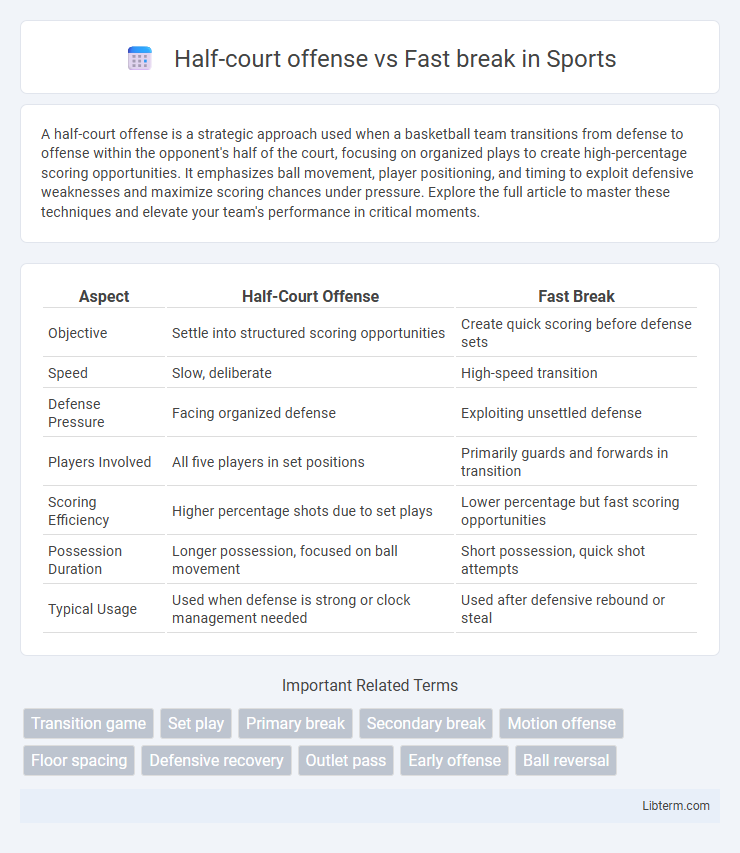A half-court offense is a strategic approach used when a basketball team transitions from defense to offense within the opponent's half of the court, focusing on organized plays to create high-percentage scoring opportunities. It emphasizes ball movement, player positioning, and timing to exploit defensive weaknesses and maximize scoring chances under pressure. Explore the full article to master these techniques and elevate your team's performance in critical moments.
Table of Comparison
| Aspect | Half-Court Offense | Fast Break |
|---|---|---|
| Objective | Settle into structured scoring opportunities | Create quick scoring before defense sets |
| Speed | Slow, deliberate | High-speed transition |
| Defense Pressure | Facing organized defense | Exploiting unsettled defense |
| Players Involved | All five players in set positions | Primarily guards and forwards in transition |
| Scoring Efficiency | Higher percentage shots due to set plays | Lower percentage but fast scoring opportunities |
| Possession Duration | Longer possession, focused on ball movement | Short possession, quick shot attempts |
| Typical Usage | Used when defense is strong or clock management needed | Used after defensive rebound or steal |
Introduction to Half-Court Offense and Fast Break
Half-court offense emphasizes structured plays, precise spacing, and coordinated movements to create scoring opportunities against a set defense, focusing on ball movement and player positioning. Fast break relies on quick transitions and exploiting numerical advantages after gaining possession, aiming to score before the opposing defense can set up. Both are fundamental basketball strategies that dictate pacing and tactical approaches during gameplay.
Defining Half-Court Offense: Structure and Strategies
Half-court offense in basketball emphasizes strategic positioning and set plays to create scoring opportunities within a confined space, relying on player movement, screens, and precise passing to break down tight defenses. Structured formations such as the motion offense, pick-and-roll, and isolation are designed to exploit mismatches and open up shots while controlling the tempo. Success in half-court offense depends on discipline, timing, and effective communication to optimize spacing and maintain offensive flow under defensive pressure.
Fast Break Offense: Speed and Transition Fundamentals
Fast break offense capitalizes on speed and quick transition from defense to offense, aiming to exploit unsettled defenses before they can organize. Mastery of outlet passes, sprinting lanes, and decision-making under pressure enhances the effectiveness of fast breaks, creating high-percentage scoring opportunities. Teams that emphasize fast break fundamentals often outpace slower half-court sets, leveraging tempo to control the game flow and increase scoring efficiency.
Key Differences Between Half-Court and Fast Break Plays
Half-court offense emphasizes structured plays, precise ball movement, and set screens to create open shots within a defined offensive setup, prioritizing patience and spacing. Fast break relies on rapid transitions, exploiting defensive mismatches and outnumbered defenders through speed and quick decision-making to score before the defense can organize. The key differences lie in pace, with half-court offense being methodical and fast break centered on acceleration and immediacy.
Tactical Advantages of Half-Court Offense
Half-court offense allows teams to execute well-structured plays that exploit defensive weaknesses through precise spacing and ball movement. This strategy enhances possession control, enabling the offense to set screens and create high-percentage shots with deliberate timing. By slowing the game pace, half-court offense reduces turnovers compared to fast breaks, increasing scoring efficiency in organized situations.
Benefits of Fast Break Offense in Modern Basketball
Fast break offense leverages rapid transitions to exploit defensive mismatches before opponents can set up, significantly increasing scoring opportunities and game tempo. This approach enhances team efficiency by maximizing possessions per game and forcing defenses into breakdowns, which heightens scoring percentages. Modern basketball analytics show teams emphasizing fast break offense yield higher point-per-possession metrics, underscoring its strategic value over half-court sets.
Situational Effectiveness: When to Use Each Offense
Half-court offense excels in structured settings where the defense is set, allowing teams to methodically create high-percentage shots through set plays and deliberate ball movement. Fast breaks are most effective immediately after defensive rebounds or turnovers, capitalizing on unsettled defenses to score quickly before opponents can set up. Choosing between these offenses depends on game pace, player stamina, and the opposing team's defensive readiness, with half-court offense favored for control and precision, and fast breaks for speed and momentum.
Player Roles in Half-Court vs Fast Break Systems
In half-court offense systems, player roles emphasize structured positioning with point guards orchestrating plays, centers posting up near the basket, and wings creating spacing for perimeter shooting. Fast break roles prioritize speed and decision-making, with guards pushing the ball quickly in transition and forwards sprinting to finish scoring opportunities before the defense sets. The contrast highlights half-court reliance on set plays and spacing, while fast breaks depend on quick outlets and finishing ability.
Training Drills for Half-Court and Fast Break Execution
Effective training drills for half-court offense emphasize spacing, ball movement, and set plays to develop timing and decision-making under pressure. Fast break execution drills focus on conditioning, quick outlet passes, and rapid transition from defense to offense to capitalize on scoring opportunities before the defense sets up. Incorporating both drill types enhances overall team versatility and improves scoring efficiency in varied game situations.
Choosing the Right Offensive Style for Your Team
Choosing the right offensive style hinges on your team's strengths and player speed; a half-court offense emphasizes structured plays, ball movement, and high-percentage shots, ideal for disciplined teams with strong shooters and decision-makers. A fast break offense leverages quick transitions, speed, and aggressive defense to create easy scoring opportunities, suited for athletic teams with depth and stamina. Evaluating your roster's skill set and conditioning is essential to maximize effectiveness and maintain consistent scoring under various game conditions.
Half-court offense Infographic

 libterm.com
libterm.com